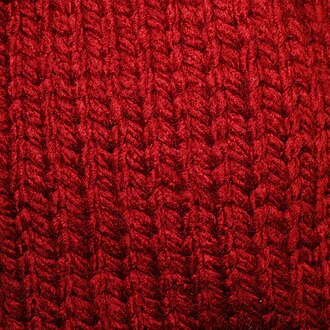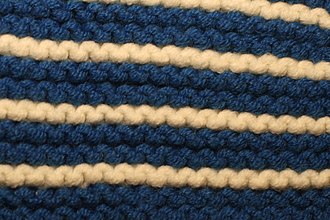Difference between revisions of "AY Honors/Knitting/Answer Key"
m |
|||
| (One intermediate revision by the same user not shown) | |||
| Line 1: | Line 1: | ||
| − | + | A few types of [[knitted fabric]] are so fundamental, that they have been adopted as part of the language of knitting, similar to techniques such as [[yarn over]] or [[decrease (knitting)|decrease]]. Examples include '''stockinette stitch''', '''reverse stockinette stitch''', '''garter stitch''', '''seed stitch''', '''faggoting''', and '''tricot'''. | |
| − | + | In some cases, these fabrics appear differently on the [[right side (knitting)|right side]] (i.e., as seen when making the stitch) than on the [[wrong side (knitting)|wrong side]] (i.e., as seen from the other side, when the work is turned). | |
| − | |||
| − | |||
| − | |||
| − | |||
| − | |||
| − | |||
| − | |||
| − | |||
| − | |||
| − | |||
| − | |||
| − | |||
| − | |||
| − | |||
| − | |||
| − | |||
| − | |||
| − | |||
| − | |||
| − | |||
| − | |||
| − | |||
| − | |||
| − | |||
| − | |||
| − | |||
| − | |||
| − | |||
| − | |||
| − | |||
| − | |||
| − | |||
| − | |||
| − | |||
| − | |||
| − | |||
| − | [[Category: | + | ==Stockinette stitch and reverse stockinette stitch== |
| + | |||
| + | [[Image:Stockinette.jpg|thumb|right|Stockinette stitch]] | ||
| + | |||
| + | '''Stockinette stitch''' is the most basic knitted fabric; every stitch (as seen from the [[right side (knitting)|right side]]) is a knit stitch. In the [[circular knitting|round]], stockinette stitch is produced by knitting every stitch; by contrast, in the flat, stockinette stitch is produced by knitting and purling alternate rows. | ||
| + | |||
| + | Stockinette-stitch fabric is very smooth and each column ("wale") resembles a stacked set of "V"'s. It has a strong tendency to curl horizontally and vertically because of the [[asymmetry]] of its faces. | ||
| + | |||
| + | '''Reverse stockinette stitch''' is produced in the same way as stockinette, except that the purl stitches are done on the [[right side (knitting)|right side]] and the knit stitches on the [[wrong side (knitting)|wrong side]]. In the [[circular knitting|round]], reverse stockinette stitch is produced by purling every stitch. | ||
| + | |||
| + | ==Garter stitch== | ||
| + | |||
| + | [[Image:Garterstitch.jpg|thumb|right|Garter stitch]] | ||
| + | |||
| + | '''Garter stitch''' is the most basic form of [[welting (knitting)|welting]], consisting of alternating rows of knit and purl stitches (as seen from the [[right side (knitting)|right side]]). In the [[circular knitting|round]], garter stitch is produced by knitting and purling alternate rows. By contrast, in the flat, garter stitch is produced by knitting every stitch (or purling every stitch, though this is much less common). | ||
| + | |||
| + | In garter-stitch fabrics, the purl rows stand out from the knit rows, which provides the basis for [[shadow knitting]]. Garter-stitch fabric has significant lengthwise [[elasticity]] and little tendency to curl, due to the [[symmetry]] of its faces. | ||
| + | |||
| + | ==Seed stitch== | ||
| + | |||
| + | '''Seed stitch''' is the most basic form of a [[basketweave (knitting)|basketweave pattern]]; knit and purl stitches alternate in every column ("wale") ''and'' every row ("course"). In other words, every knit stitch is flanked on all four sides (left and right, top and bottom) by purl stitches, and vice versa. | ||
| + | |||
| + | Seed-stitch fabrics lie flat; the symmetry of their two faces prevents them from curling to one side or the other. Hence, it makes an excellent choice for edging, e.g., the central edges of a cardigan. However, seed stitch is "nubbly", not nearly as smooth as stockinette. | ||
| + | |||
| + | ==Faggoting== | ||
| + | |||
| + | '''Faggoting''' is an variation of [[lace knitting]], in which every stitch is a [[yarn over]] or a [[decrease (knitting)|decrease]]. There are several types of faggoting, but all are an extremely open [[lace]] similar to [[netting]]. Like most lace fabrics, faggoting has little structural strength and deforms easily, so it has little tendency to curl despite being asymmetrical. | ||
| + | |||
| + | ==Tricot knitting== | ||
| + | |||
| + | '''Tricot''' is a special case of [[warp knitting]], in which the yarn zigzags vertically, following a single ''column'' ("wale") of knitting, rather than a single ''row'' ("course"), as is customary. Tricot and its relatives are very resistant to runs, and are commonly used in [[lingerie]]. | ||
| + | |||
| + | ==Other basic fabrics== | ||
| + | |||
| + | Other classes of basic knitted fabrics include [[ribbing (knitting)|ribbing]], [[welting (knitting)|welting]] and [[cable knitting|cables]]. | ||
| + | |||
| + | ==Reference== | ||
| + | |||
| + | * June Hemmons Hiatt (1988) ''The Principles of Knitting'', Simon and Schuster, pp. 18-20. ISBN 0-671-55233-3 | ||
| + | |||
| + | [[Category:Knitting]] | ||
Revision as of 06:26, 18 December 2006
A few types of knitted fabric are so fundamental, that they have been adopted as part of the language of knitting, similar to techniques such as yarn over or decrease. Examples include stockinette stitch, reverse stockinette stitch, garter stitch, seed stitch, faggoting, and tricot. In some cases, these fabrics appear differently on the right side (i.e., as seen when making the stitch) than on the wrong side (i.e., as seen from the other side, when the work is turned).
Stockinette stitch and reverse stockinette stitch
Stockinette stitch is the most basic knitted fabric; every stitch (as seen from the right side) is a knit stitch. In the round, stockinette stitch is produced by knitting every stitch; by contrast, in the flat, stockinette stitch is produced by knitting and purling alternate rows.
Stockinette-stitch fabric is very smooth and each column ("wale") resembles a stacked set of "V"'s. It has a strong tendency to curl horizontally and vertically because of the asymmetry of its faces.
Reverse stockinette stitch is produced in the same way as stockinette, except that the purl stitches are done on the right side and the knit stitches on the wrong side. In the round, reverse stockinette stitch is produced by purling every stitch.
Garter stitch
Garter stitch is the most basic form of welting, consisting of alternating rows of knit and purl stitches (as seen from the right side). In the round, garter stitch is produced by knitting and purling alternate rows. By contrast, in the flat, garter stitch is produced by knitting every stitch (or purling every stitch, though this is much less common).
In garter-stitch fabrics, the purl rows stand out from the knit rows, which provides the basis for shadow knitting. Garter-stitch fabric has significant lengthwise elasticity and little tendency to curl, due to the symmetry of its faces.
Seed stitch
Seed stitch is the most basic form of a basketweave pattern; knit and purl stitches alternate in every column ("wale") and every row ("course"). In other words, every knit stitch is flanked on all four sides (left and right, top and bottom) by purl stitches, and vice versa.
Seed-stitch fabrics lie flat; the symmetry of their two faces prevents them from curling to one side or the other. Hence, it makes an excellent choice for edging, e.g., the central edges of a cardigan. However, seed stitch is "nubbly", not nearly as smooth as stockinette.
Faggoting
Faggoting is an variation of lace knitting, in which every stitch is a yarn over or a decrease. There are several types of faggoting, but all are an extremely open lace similar to netting. Like most lace fabrics, faggoting has little structural strength and deforms easily, so it has little tendency to curl despite being asymmetrical.
Tricot knitting
Tricot is a special case of warp knitting, in which the yarn zigzags vertically, following a single column ("wale") of knitting, rather than a single row ("course"), as is customary. Tricot and its relatives are very resistant to runs, and are commonly used in lingerie.
Other basic fabrics
Other classes of basic knitted fabrics include ribbing, welting and cables.
Reference
- June Hemmons Hiatt (1988) The Principles of Knitting, Simon and Schuster, pp. 18-20. ISBN 0-671-55233-3


